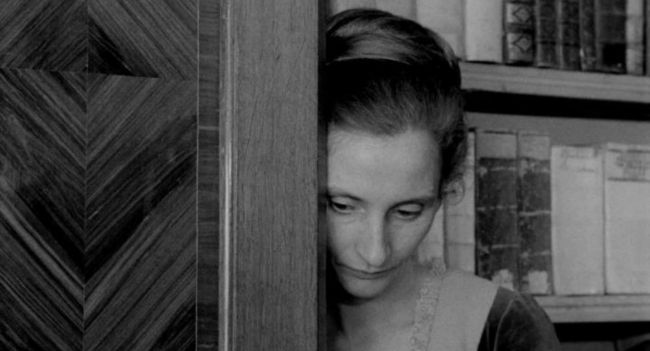Jean-Marie Straub and Danièle Huillet’s The Chronicle of Anna Magdalena Bach, entirely played by professional musicians, is a peculiar and striking film.

A scene from Jean-Marie Straub & Danièle Huillet’s Chronicle of Anna Magdalena Bach (image courtesy Grasshopper Film)
One of the striking features of Jean-Marie Straub and Danièle Huillet’s The Chronicle of Anna Magdalena Bach (1968) is its stillness. You want to hold your breath as Bach’s music soars with rigorous ferocity. The film’s crucial paradox is that, just like any great music performance, the film’s apparent stillness nevertheless emanates tension.
In the film’s first sequence, a close-up of a musician playing opens up to reveal an entire ensemble, and then quickly cuts to a profile of a young woman, before it cuts back to the music. In the voiceover, a woman tells us that her family members were also musicians, as was she — a singer at the court. The woman thus presented is Anna Magdalena Bach (played by musician Christiane Lang), Bach’s wife, a figure known only to those particularly familiar with Bach’s biography. And while the film is mostly focused on the music and the settings in which it was originally played, Anna Magdalena’s voice guides us, providing the film’s peculiar, illusive texture. Unlike many of the filmmakers’ works, The Chronicle of Anna Magdalena Bach has been restored, and the restored copy is playing at Quad Cinema in the West Village for the film’s 50th anniversary.

Gustav Leonhardt in a scene from Jean-Marie Straub & Danièle Huillet’s Chronicle of Anna Magdalena Bach (image courtesy Grasshopper Film)
As is always the case with Straub-Huillet (as the director duo is known), The Chronicle’s narrative elements are pared down to a minimum. The camera is motionless, the black-and-white photography crisp and clean, and shot in natural light. Professional musicians — most notably Gustav Leonhardt as Bach — play all the parts. Significantly, Leonhardt was at the forefront of authentic music performance, a movement in the 1960s that advocated the use of original instruments, such as the harpsichord, rather than contemporary ones, such as the piano.
Straub-Huillet are similarly dedicated to authentic presentation. They include period costumes and locations, such as German churches and halls, where Bach’s music was originally presented. At the same time, they avoid providing an entirely fictional biographical account of Bach’s life. In fact, we are never quite made to believe that Leonhardt is Bach, even though our natural impulse to seek glimpses of the personal in art is so great that the film is described to this day as portraying “the life and music of Bach.”
Leonhardt is first and foremost a musician in period costume. His “embodiment” of Bach is mainly through music rather than fictional anecdotes. As he plays, our eye is drawn to his fingers, to the textures of clothing and of his wig, and to the original details of instruments and architecture — in other words, to the performative aspects, which cinematic composition brings out with greater clarity.

Christiane Lang in a scene from Jean-Marie Straub & Danièle Huillet’s Chronicle of Anna Magdalena Bach (image courtesy Grasshopper Film)
Like Samuel Beckett, whose approach to dialogue and line delivery was famously rigorous, Straub-Huillet are known for purging their filmic dialogue of natural inflections. The lines in their films never lose the striking, often flat quality of recitation. As a result, they ring “off,” to the point of artifice. The Straub-Huillet method, often also likened to Bertolt Brecht’s theatrical tactic of estrangement, is profoundly intellectual. Yet to say that Straub-Huillet appeal to the intellect alone would do injustice to the curious, and, in the end, quite emotional effect that the film can have on viewers. Firstly, the music is glorious. And the effects of natural light remind us of what we often sense when visiting Baroque churches: the uplifting effect of sunlight, the expansiveness of space, and the fluidity of design.
Even more affecting and radical is Straub-Huillet’s invention of Anna Magdalena Bach’s diary, and thus the personalization of what otherwise would have been a mere string of facts. Which is not to say that Anna Magdalena appears to us as a fleshed-out character; that would have gone against Straub-Huillet’s aesthetic. The scenes with any dramatic function are exceedingly rare. Lang’s line delivery is brisk; she sounds more like a performer reading a text — to reinforce this, Straub-Huillet include numerous images of script and music sheets. In the voiceover, we hear Anna Magdalena narrate some aspects of her husband’s life. These aspects range freely: dates and places of performances, records of financial grievances, consecutive births and deaths of children. It is a rather wanton kaleidoscopic vision, intrinsically partial and fragmented that pays no homage to the grandeur of the composer’s life. And it is here that the film’s real stark beauty lies: in the radical gesture of single-handedly effacing a myth, or rather, in giving it an earthly dimension, against the background of Anna Magdalena’s devoted yet silenced domesticity.
As per Bach’s renowned biographer, Christoph Wolff, the great composer and court musician was very invested in propagating his own myth. So was the Romantic Germany devoted to the singular myth of genius, and then the Nazi Germany as it aestheticized its politics of extermination. Straub-Huillet dethrone this tendency. With no plot, except for a few impressionistic threads, no action except for the musicians’ muscles straining, we are asked to experience Bach as the uttermost Baroque expression: a strange, wondrous sound that rings austere to our ears, but whose ambition, as Bach himself put it, was no less than “the honor of God and the recreation of the soul.”
The Chronicle of Anna Magdalena Bach by Jean-Marie Straub and Danièle Huillet is screening at the Quad (34 West 13th Street, West Village, Manhattan) Friday, March 2–Thursday, March 8.
